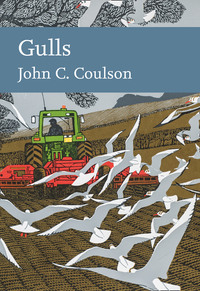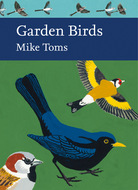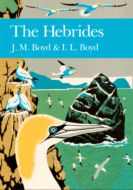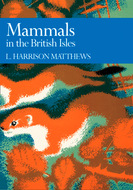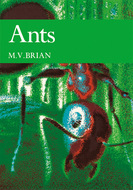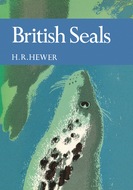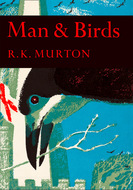Kitap dosya olarak indirilemez ancak uygulamamız üzerinden veya online olarak web sitemizden okunabilir.
Kitabı oku: «Gulls»

Copyright
William Collins
An imprint of HarperCollinsPublishers 1 London Bridge Street London SE1 9GF WilliamCollinsBooks.com This eBook edition published by William Collins in 2019 Copyright © John C. Coulson, 2019 Photographs © Individual copyright holders John C. Coulson asserts his moral right to be identified as the author of this work Cover design linocut by Robert Gillmor A catalogue record for this book is available from the British Library. All rights reserved under International and Pan-American Copyright Conventions. By payment of the required fees, you have been granted the non-exclusive, non-transferable right to access and read the text of this eBook on-screen. No part of this text may be reproduced, transmitted, downloaded, decompiled, reverse engineered, or stored in or introduced into any information storage and retrieval system, in any form or by any means, whether electronic or mechanical, now known or hereinafter invented, without the express written permission of HarperCollins Publishers. Source ISBN: 9780008201425 Ebook Edition © April 2019 ISBN: 9780008201449 Version: 2019-02-11
EDITORS
SARAH A. CORBET, SCD
DAVID STREETER, MBE, FRSB
JIM FLEGG, OBE, FIHORT
PROF. JONATHAN SILVERTOWN
PROF. BRIAN SHORT
*
The aim of this series is to interest the general
reader in the wildlife of Britain by recapturing
the enquiring spirit of the old naturalists.
The editors believe that the natural pride of
the British public in the native flora and fauna,
to which must be added concern for their
conservation, is best fostered by maintaining
a high standard of accuracy combined with
clarity of exposition in presenting the results
of modern scientific research.
Contents
Cover
Title Page
Copyright
About the Editors
Editors’ Preface
Author’s Foreword and Acknowledgements
1 An Overview of Gulls
2 Black-headed Gull
3 Mediterranean Gull
4 Common Gull (Mew Gull)
5 European Herring Gull
6 Lesser Black-backed Gull
7 Great Black-backed Gull
8 Black-legged Kittiwake
9 Yellow-legged Gull
10 Little Gull
11 Rare Gulls in Britain and Ireland
12 Methods Used to Study Gulls
13 Urban Gulls
14 Conservation, Management and Exploitation of Gulls
Appendices
Select Bibliography and Further Reading
Species Index
General Index
About the Author
About the Publisher
Editors’ Preface
GULLS ARE A FAMILY OF DISTINCTIVE and easily recognised birds that are familiar to us all, whether we live close to the sea or many miles inland, and whether we live in urban or rural surroundings. Long gone are the days when the sight of flocks of gulls overhead or in nearby fields was taken as a sure and ominous sign of storms at sea. For most of us today, birdwatchers or not, gulls are genuinely everyday birds, as common a sight as Woodpigeons (Columba palumbus) or the various members of the crow family. Other than in immature plumages (which may cause problems), the handful of commoner species are readily identifiable to those with any interest.
Seeking an expert author for a new book on gulls was a relatively easy task for the editors. Dr John Coulson was, until his retirement, Reader in Animal Ecology at the University of Durham, and has a lifetime’s experience of research into many aspects of gull (and other seabird) biology and ecology, with a particular focus on the Black-legged Kittiwake (Rissa tridactyla). He is an expert of world renown, and recipient in 1992 of the British Ornithologists’ Union’s highest accolade, the Godman-Salvin Medal, and in 1993 of the Waterbird Society’s Robert Cushman Murphy Prize.
A fulsome initial chapter introduces the gull family as a whole, including a succinct assessment of the rather complex current (worldwide) status of gull taxonomy. Things have changed dramatically since the eighteenth century, when Carl Linnaeus first established the single genus Larus, containing all the then known species! After this, the reader is treated to nine chapters – each in effect a treatise – on the regular British and Irish gulls, including the latest newcomer, the rapidly increasing and very elegant Mediterranean Gull (Ichthyaetus melanocephalus). These are followed by chapters on the rarer species; methods used in studying gulls; urban problems; and conservation, management and exploitation.
In common with many components of our fauna and flora, times have changed for gulls, and not always for the better – as the author describes. They may not universally be seen as slender-winged, elegant seabirds, and to some – especially those living in or visiting towns or cities with rooftop gull colonies – they are raucously noisy neighbours. Similarly, many seaside promenades are blighted by the menacing presence of gulls with unblinking eyes seeking scraps, often boldly. Since the late twentieth century, even conservation bodies seeking to encourage nesting terns or other seabirds have resorted to culling in an attempt to limit predatory gull activity. In the last few decades, however, Herring Gull numbers, boosted in the second half of the twentieth century by the ready feeding opportunities offered by poorly covered landfill sites, have fallen to the extent that they themselves have become of conservation concern.
Such problems, as well as the many fascinating but less nefarious aspects of our British and Irish gull populations, are dealt with in substantial detail in John Coulson’s admirably comprehensive text. This is a most noteworthy addition to the New Naturalist Library.
Author’s Foreword and Acknowledgements
MY FIRST RECOLLECTION OF GULLS was when I was about eight years old, when a maritime pilot on the Tyne told me that the gulls that frequently followed commercial ships entering the busy river were the reincarnations of past pilots, and were keeping a supportive eye on the steering of current pilots. An individual gull the pilots recognised because it called frequently was said to be the reincarnation of pilot ‘Clagger’ Purvis, who apparently had had as much to say for himself in life. Even at that age I found this story hard to believe, but the pilot was right about the frequency of gulls following both large and small vessels into the river.
My interest in birds, and particularly in gulls, developed during my school days. As a member of a small group mentored by Fred Grey, a master at South Shields High School for Boys and a person with a lifelong passion for birds, I learned much about the identification of birds during mid-morning breaks and on field trips. Through his guidance, my questioning eventually expanded from ‘What is it?’ to ‘What is it doing?’ I was also very much influenced by the Reverend Edward Armstrong’s book Bird Display and Behaviour (1942), David Lack’s The Life of the Robin (1943) and, in particular, Sir Arthur Landsborough Thomson’s Bird Migration (1936), which highlighted some of the information that could be gained by ringing birds.
While still in the sixth form at school, I wrote to Elsie Leach, who ran the national bird-ringing scheme in an honorary capacity for the British Trust for Ornithology (BTO) from a small office and a cupboard in the Natural History Museum in London, asking her how to become a ringer. I received a prompt response requesting a letter of support from an acknowledged ornithologist that I could identify birds. I obtained this from a local doctor; he had an excellent knowledge of the birds of northern Norway and I had previously been able to draw his attention to uncommon birds visiting the vicinity, which he would stop off to see while making slight detours en route to his house calls.
Having sent the recommendation to Miss Leach, I received a reply within a few days simply asking what numbers and sizes of rings I wanted. At that time, 1948, there was no training whatsoever for potential ringers, nor an age limit. Every ring used had to be recorded on a thin cardboard sheet, which took only six ring entries and was guillotined into separate strips if the ringed bird was recovered. Ringing was on a very much smaller scale in those days! I remained an active ringer for 62 years, and have seen many changes to the British ringing scheme, including the intensive training now required for those who wish to ring. I also received one of the first mist nests in the country, and had to work out for myself how to use it – all I was told was to hang it between two poles!
One day in early June 1950, Edward White (a school and university friend) and I walked along the coast to where Black-legged Kittiwakes (Rissa tridactyla, here referred to simply as Kittiwakes) were nesting on a stack called Marsden Rock and on the nearby mainland cliffs. As we walked on the beach below the colonies, we noticed that about a third of the nests on the stack contained chicks, while only one out of a hundred nests on the mainland cliffs had chicks. Two weeks later, we excluded predation as the cause of this difference, as almost all nests now contained chicks, even though those in nests on the mainland cliff tended to be smaller than those on the stack.
This brief observation started a chain of interest and speculation. Why was there this difference, which was obviously not due to predation? Our attention was drawn to Frank Fraser Darling’s book Bird Flocks and the Breeding Cycle (1938). The local public library managed to borrow a copy from another library and we were able to read about the ecologist’s idea of social stimulation, which he believed affected the timing and success of breeding in colonial birds. Some authors suggested that the differences Fraser Darling had observed in small colonies of large gulls were due to young birds breeding later than old individuals, and that more young birds were breeding in some colonies than in others. However, we failed to find any information on the effect of age on the breeding biology of gulls and very little on birds of any species.
Edward and I were both undergraduates at Durham University, and we planned to make twice-weekly visits the following year to the Kittiwake colonies at Marsden to count the numbers of nests containing chicks (counting when eggs were laid was not possible, as most nests could not be viewed from above). The difference we had observed the previous year was repeated, and we presented our first results at one of the delightfully informal annual student bird conferences held at St Hugh’s College in Oxford each January, organised by David Lack. This resulted in the opportunity to meet and engage with many knowledgeable researchers, including Niko Tinbergen, Charles Elton, Arthur Cain, Mike and Esther Cullen, ‘Mick’ Southern, Reg Moreau, David Snow, Lance Richdale and, of course, David Lack and his students.
The problem of whether the differences we found between colonies were an effect of age or social conditions required knowledge of the breeding biology of Kittiwakes of different ages and, in turn, this needed marked individuals whose ages were known. The nests on the limestone cliffs at Marsden were inaccessible, but by chance, while crossing the river Tyne on a ferry two years previously, I had noticed a few pairs of Kittiwakes nesting on the window ledges of a riverside warehouse at North Shields. At Durham University, the head of zoology, Professor J. B. Cragg, was kind enough to take an interest in our study and in 1953 he obtained access for us to the building from the owners, Smith’s Dock Co. The company actively protected the Kittiwakes and the birds were the delight of the two employees working there. We were able to reach the nests from inside the warehouse, allowing us to capture and individually mark the breeding adults and chicks. Fate was very kind to us, because the windows on the ledges used by the Kittiwakes opened inwards, and we were able to snare adults without pushing off or even disturbing the nests and their contents. Our main tool was a 60 cm length of wire, which had been used to bind a crate of oranges. We shaped one end into a crook that could be passed out of a narrow gap when the window was ajar and slipped around the leg of the adult. The Kittiwakes were not alarmed by the wire, and indeed were often curious and pecked at it. Pairs on neighbouring windowsills did not react when an individual suddenly disappeared into the ‘cliff’ to be colour-ringed. Within a few years we were able to measure the timing of laying in individuals of different ages.
The study eventually spanned more than 35 years, although there was never any guarantee that we would be able to continue it beyond a year or two at a time. At that time, long-term studies on birds were virtually unknown, the exception being that undertaken by Huijbert Kluijver on Great Tits (Parus major) in the Netherlands (which began in 1912), and it was many years before the research councils in the UK appreciated their considerable value and supported some of them.
The opportunity arose for both Edward and me to study for a PhD, but independently we came to the same opinion that a doctorate in ornithology was unlikely to lead to employment. There were only three people at that time professionally employed as ornithologists in Britain, and one of these held a post of reader in entomology! Only two universities employed ornithologists (Oxford and Aberdeen), and there was one ornithologist who worked for the Ministry of Agriculture and Fisheries. An eminent Scottish professor of zoology at that time openly stated that the study of birds and butterflies was not part of zoology, and ecology was only just starting to develop in Oxford, under the influence of Charles Elton, David Lack and Alister Hardy.
This situation was in marked contrast to the present day, when many of the now much more numerous universities have one or usually more staff researching in ornithology and ecology, while currently Natural England, the BTO, the Game and Wildlife Conservation Trust, Scottish Natural Heritage and the Royal Society for the Protection of Birds (RSPB) all employ professional ornithologists. Because of the situation in 1953, Edward and I both decided to work on entomological topics for our higher degrees, and studying Kittiwakes remained a happy hobby.
Our cooperative studies of Kittiwakes had to cease after we both completed our PhD studies. Edward went to work at a college in Freetown, Sierra Leone, and then moved to New Zealand. I went into school teaching but continued the Kittiwake studies in my spare time. Eventually, I obtained a post-doctoral fellowship from the Royal Commission for the Exhibition of 1851, and this allowed me to develop a full-time research programme of my own choice – the study of both Kittiwakes and moorland insects.
Two years later, I was offered a lectureship in zoology at Durham University, and in the following years I supervised a series of students working on seabirds and also on moorland invertebrates. Those studying seabirds included Jeff Brazendale, Brian Springett, Dick Potts, Andy Hodges, Ron Wooler, Jean Horobin, Callum Thomas, Jennifer Butterfield, Julie Porter, John Chardine, Fiona Dixon, David Jackson, Nicholas Aebischer and Jackie Fairweather, many of whom worked with me using the individually marked Kittiwakes nesting on the warehouse at North Shields from 1961 to 1990. Étienne Danchin visited from France and contributed much to Kittiwake studies during his post-doctoral year at Durham. In addition, Tom Pearson made a comprehensive study of the feeding biology of seabirds, including Kittiwakes, European Herring Gulls (Larus argentatus, here referred to simply as Herring Gulls) and Lesser Black-backed Gulls (L. fuscus) breeding on the Farne Islands, Northumberland.
Dick Potts started a PhD study on Shags (Phalocrocorax aristotelis) in 1962, and this took us to the Isle of May in Scotland’s Firth of Forth. There, we met those managing the Isle of May Bird Observatory, who were concerned about the lack of use their accommodation and facilities received during the summer. As a result, they encouraged me to start studies on the tens of thousands of Herring Gulls nesting on the island. First, Jasper Parsons, and then Neil Duncan and George Chabrzyk, developed studies on the large gull colony, while the contribution started by Margaret Emmerson was sadly curtailed by her untimely death. We continued studies on Herring Gulls for 11 years, until the major and ‘experimental’ reduction of the large gulls on the island that was carried out by the Nature Conservancy Council. Elsewhere in Britain, Niko Tinbergen had researchers working on gulls at Ravenglass and the Isle of Walney in Cumbria, and more recently several others have studied large gulls nesting on islands in south Wales.
Herring Gulls started to invade and breed in coastal towns in north-east England in the 1960s, and Pat Monaghan was the first to study these and others feeding at landfill sites in detail. We mapped the distribution and rapidly increasing numbers of large gull species nesting in urban areas throughout Britain and Ireland in 1977, building on Stanley Cramp’s initial study. Twenty years later, Susan Raven and I repeated the national census and found both a dramatic spread and increases in numbers.
Investigations on Lesser Black-backed Gulls breeding on Tarnbrook Fell were started by Neil Duncan, and later developed further by Mark O’Connor and Nick Royle, with the aim of establishing non-lethal methods to reduce the extent of the large gull colony there. From 1999 to date, my wife, Becky, and I have studied and counted Herring Gulls nesting in South Shields, Sunderland, Newcastle upon Tyne and Berwick-upon-Tweed in north-east England, and Lesser Black-backed Gulls in Dumfries in south-west Scotland.
In 1992, a new Kittiwake colony was established on the low cliffs of Coquet Island, Northumberland. With the goodwill of the RSPB, Becky and I were able to ring every chick reared there for the first 15 years of the colony’s existence, and so were able to identify the huge immigration of adults reared in other colonies as the Coquet colony rapidly grew in size.
The Natural Environmental Research Council supported my research on gulls in collaboration with their Unit of Virology, which was concerned with the possibility of viruses being carried and distributed by the birds. This involved post-doctoral studies by Neil Duncan, Callum Thomas and Jennifer Butterfield, aided by Nicholas Aebischer, David Jackson and Sarah Wanless. The range of the study was expanded from the north of England to include Scotland, with Pat Monaghan working from Glasgow University, where she had recently been appointed as a lecturer. This work subsequently led to a joint study by Susan Greig, Pat Monaghan and myself on gull feeding methods at landfill sites, which relied on video recordings and then frame-by-frame play-backs of the feeding activity of individually marked gulls of known sex and age during their mass feeding frenzies. Collaborative work was developed with the Public Health Laboratory Service over several years on the microorganisms carried by gulls (particularly Salmonella, Campylobacter and Cryptosporidium). Later, Gabriella MacKinnon and David Baines carried out studies on wintering Black-headed Gulls (Chroicocephalus ridibundus) and Common Gulls (Larus canus).
I have also had considerable exchange of ideas with gull researchers from other countries, in particular Rudi Drent and Arie Spaans in the Netherlands, and Ian Nisbet, Michael Gochfeld and Joanna Burger in the United States. In addition, I have had the pleasure of meeting very many others at international ornithological congresses.
My studies on gulls developed rapidly at Durham with the cooperation of a large series of dedicated and able researchers, well supported by a number of technicians, particularly Eric Henderson, Michael Bone and John Richardson. In addition, we received welcome financial support at different times from the Department of Scientific and Industrial Research, the Science Research Council and the Natural Environment Research Council, supporting facilities supplied by Durham University itself.
Ornithology, including the study of seabirds, has expanded considerably since 1950, and the worldwide output of publications on aspects of the biology of gulls has consequently increased at a remarkable rate. Many, but by no means all, ornithological publications are listed annually in Zoological Record, and it is remarkable how the number of scientific papers included there has increased 15-fold since 1950. Journals such as Ibis, Bird Study, Ardea, Auk and British Birds, along with several journals published in North America, have greatly increased the annual number of pages dedicated to ornithology, while many new journals have also been started. Having been an editor of three ornithological journals over a period of 40 years, I have been particularly aware of this change and, incidentally, the increasing number of papers with multiple authors. In part, this results from more cooperative studies, but perhaps also from the increasing demands (and needs) of students to publish with tenured members of staff so their work can be included in research assessments. In the 1950s and 1960s, most scientific papers in ornithology had single authorship, with a minority having two authors. Recently, however, there has been a change – for example, in a recently published issue of 24 papers in one symposium, the contributions averaged more than four authors per paper, two having 12 authors and one 13, while only two were written by a single author.
The numbers of ornithological papers published in ecological and behavioural journals has also increased dramatically. These, together with information on gulls published elsewhere, such as annual county reports and those of conservation bodies, theses, records, online reports and books, have increased almost beyond belief, to such an extent that a complete bibliography for this book would have been taken up more than fifty pages and the main text would have been littered with multiple references to data sources. In 2011, my monograph on the Kittiwake required 16 pages of bibliography for this one species alone. In dealing currently with the Herring Gull, the references consulted exceeded a thousand items, and since this book covers the information on all gulls on the British list, I found that including a complete bibliography was a major problem. Providing references in books is not new problem, however, and was one faced by both James Fisher when writing The Fulmar (New Naturalist Monograph 6) in 1952 and Niko Tinbergen in his Herring Gull’s World in 1953.
This book has had the main objective of bringing together and digesting information on the gull species that occur in Britain and Ireland, and is primarily aimed at readers who are interested in gulls but not necessarily in researching their biology in depth. In discussing this problem with the editors and others, I have been encouraged to reduce the number of references reported in the text appreciably, and instead present a Select Bibliography and Further Reading section at the end of the book (here), and listing select key studies mentioned in the text, along with other informative publications. Readers wishing for more information should be able to obtain further details from the extensive sources available on the Internet. The extent of published (and unpublished) information on gulls is now so extensive that I have had to be selective about the information presented for several species, and I have been able to include information and analyses not previously published or available to most readers.
This book is not meant as an identification guide, although some of the salient features of each species and their geographical distribution are briefly mentioned. Those wishing to identify gulls should use one of the excellent field guides available, as listed in the Select Bibliography. The world distributions of all gull species considered here have been fully described in standard identification texts, including the gull sections in volume 3 of the Birds of the Western Palaearctic and volume 3 of the Birds of the World.
It has not been possible to write this book without encountering areas of controversy, which include taxonomy, conservation, and the ability to identify some closely related species and subspecies in the field. Ornithology has thrived on controversy in the past and it will continue to do so in the future. In many cases, disagreement has led to the development of new methods of study and more in-depth investigations. In writing this book, debate has reared its head about where a species is placed in red or yellow categories of conservation concern based on a series of possible criteria, the existence of any one of which is enough to indicate that it is threatened. Some ornithologists feel that the system should be improved, and that a more critical scientific approach is needed to interpret data used to estimate the current risk of extinction of individual gull species.
For the same reason, there is no comment on climate change in this book. While there have been several claims that this has affected gulls, sound evidence in favour of such effects is currently poor and is not supported by evidence that adequately allows other possible causes to be excluded. Increasing studies have been made to estimate the potential risks to gulls from offshore wind farms and the rotating arms of the turbines. At present, most of these are based on informed speculation and such factors as the flight height of individual species and their numbers in the key areas. In the future, this problem will be investigated in more detail and the level of the perceived risk to gulls and other seabirds will be based on actual information, not just models of the situation, but the research is not yet at this stage.
In recent years, the common names of some gulls have lengthened, allegedly to avoid international confusion. Hence, the Black-legged Kittiwake, European Herring Gull, American Herring Gull and Yellow-legged Gull join the Lesser Black-backed Gull, Great Black-backed Gull, Black-headed Gull and Slender-billed Gull, which already have long names. Proposals have been made to change the Great Black-headed Gull to the shorter Pallas’s Gull, while it has been suggested that the Common Gull is changed to the Mew Gull. In this book, as mentioned earlier, Herring Gull is used for the European Herring Gull and the American Herring Gull is referred to in full. Similarly, and as mentioned above, the Black-legged Kittiwake is referred to as the Kittiwake, while its sibling species, the Red-legged Kittiwake (which is infrequently mentioned) is written out in full. In most cases this follows the vernacular English names listed in the ninth edition of ‘The Simple British List Based on a Checklist of Birds of Britain’ (2018). In general, this edition retained names already familiar to most readers.
Statistical tests are important in evaluating differences in quantitative data, but to many the presentation of these and their outcomes are but an irritation. In general, I have commented on quantitative differences only when they have been shown to be statistically significant and so are likely to be real and meaningful, although I have not given details of the tests used.
ACKNOWLEDGEMENTS
Much of the information in this book derives from two sources. Some comes from professional research, but much is the result of the activities of amateur birdwatchers who spend their spare time visiting sites where they are likely to encounter unusual bird species or birds in exceptionally large numbers, and who then send the details to local recorders or contribute to national surveys and national censuses. Over the years, the number of observers has increased markedly and systems of notifying others of the presence of unusual birds have developed. Both categories of people studying birds have swelled progressively over the past 60 years, and the information and numbers of records have increased to a remarkable extent. In addition, the methods of identifying and confirming rare species have been increasingly supported by good-quality photographs. Accompanying these trends has been a dramatic increase in the numbers of gulls ringed both in Britain and Ireland, and also elsewhere in Europe. Capturing and ringing adult gulls has increased dramatically in recent years with the development of cannon nets and more frequent visits to landfill sites by teams of ringers. All of these additional efforts are appreciated, for without them, much of the information in this book would not have been available.
I would like to acknowledge the detailed contribution of Alan Dean, both for his detailed analysis of the records of gulls in the West Midlands in England over many years and for the photographs he (and others) have so willingly contributed.
The data used in writing this book has been collected over many years and it is possible here to identify only a small number of the hundreds of contributors. The many research students I supervised and advised have all made appreciable contributions over the years, and many have since made further contributions in ornithology and science in general while holding permanent posts both in the UK and North America. I was fortunate in having such an able set of students who contributed wholeheartedly and consistently to studies often made under difficult conditions. They all willingly volunteered to take part in teamwork as required, often at the most unsocial hours of the day and in adverse weather conditions, all while advancing their own studies.
